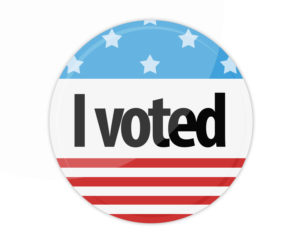Like more than 75 million people, I have already cast my vote. My husband and I were there on the first day of early voting in our state. Millions of voters are willing to stand in long lines to vote. And at a time when new  COVID-19 cases are averaging over 72,000 a day.
COVID-19 cases are averaging over 72,000 a day.
We are on track for record voter turnout before the election is over. In 2016, about 60% of eligible voters actually voted. Given early voting numbers, the projected 2020 total votes could be record breaking at over 150 million compared to about 135 million in 2016. Voter suppression is real and has taken many forms in this election cycle. It is already too late for mail-in ballots in many states – you will have to take it to a dropbox. And yet, early voting is at a record high.
Yes, I voted for Biden. That should be no surprise if you know me or have read many of my blog posts. I do believe this is the most consequential election in our lifetime. When the votes are counted, it will be either Biden or Trump.
The number of undecided voters is at a record low. If you are one of those undecided voters or leaning towards Trump despite all your concerns, I offer up a few statements for your consideration from some unlikely sources on why they also support Biden:
- Former Republican Party Chairman, Michael Steele has endorsed Biden. He clearly and thoughtfully articulates his position as a longtime Republican in a recent podcast “My Country Matters: Why I am Endorsing Biden”. In the last few minutes of it, he talks about leadership, decency, and character. He quotes Dr. Martin Luther King, Jr. in saying “Our lives begin to end the day we become silent about things that matter.”
- A conservative New Hampshire newspaper, The Union Leader, has not endorsed a Democrat for President in a 100 years. Their editorial “Our Choice is Joe Biden” says “We have found Mr. Biden to be a caring, compassionate and professional public servant. He has repeatedly expressed his desire to be a president for all of America, and we take him at his word. Joe Biden may not be the president we want, but in 2020 he is the president we desperately need. He will be a president to bring people together and right the ship of state.”
- The CEO of Expensify, David Barrett, has publicly endorsed Biden in an email to 10M customers entitled “Protect democracy, vote for Biden”. In his opening he says, “That’s right, I’m saying a vote for Trump, a vote for a third-party candidate, or simply not voting at all — they’re all the same, and they all mean — I care more about my favorite issue than democracy. I believe Trump winning is more important than democracy. I am comfortable standing aside and allowing democracy to be methodically dismantled, in plain sight.” His full email is included in this Business News article.
I saw a story of a 102-year-old woman born before women had the right to vote who said this is the most consequential election in her life as she cast her vote. If she can get out and vote, so can you.
Don’t sit this one out. Make a plan to vote and help your family and friends make a plan. Make your voice heard. Every vote matters. This election must be decided at the ballot box by your vote, not the courts.
Resources and Related Posts:



